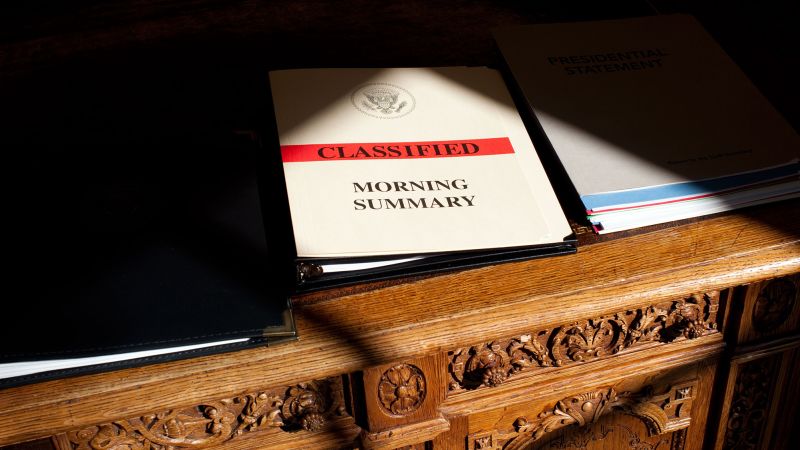Editor’s Note: Beth Sanner is a former deputy director of National Intelligence for Military Intelligence, a position where she oversaw the elements that coordinate and lead collection, analysis, and program oversight throughout the Intelligence Community. In this role she also served as the president’s intelligence briefer. She is a professor-of-practice at the Applied Research Lab for Intelligence and Security at the University of Maryland and a CNN national security analyst. The opinions expressed in this commentary are her own. View more opinion on CNN.
CNN
—
The recent revelations that both President Joe Biden and former President Donald Trump retained classified material in unsecured, unauthorized locations while not in government have prompted many to ask, “How could this have happened?”

To be sure, non-partisan efforts to answer that question (and others) and institute rigorous White House record management are required. Even then, however, it is likely more classified material will be discovered “outside the wire” in the future unless we tackle another underlying issue: too much classified paper in circulation.
The mountain of classified material flowing around the White House – and other national security agencies and departments – presents an inherent vulnerability no amount of finger-pointing or procedural reform will solve. As a former White House National Security Council (NSC) staffer, I can attest to the fact there has never been an airtight, centralized process to track this paperwork. Nor would any such effort be effective.
Paper moves, and in most cases, no one knows it is missing unless or until it is found.
So where does this mountain of classified paper come from? Let’s look again at the White House, where it is both routine and essential that staff circulate classified documents with each other and the president.
NSC staff routinely prepare binders of classified documents to inform policy discussions, interactions with foreign leaders and trips abroad. The national security adviser, White House chief of staff and senior NSC staff all provide classified material to the president, sometimes during planned meetings, sometimes impromptu. The intelligence community delivers classified written analysis, charts and maps; throughout the day, the White House Situation Room delivers classified hard-copy intelligence reports, diplomatic communications and policy proposals. These scenes similarly play out at every agency or department involved in national security.
With this in mind, it is easy to imagine how classified material might make its way into the wild, even in the most benign of circumstances. While paper cannot be hacked, it can be intermingled with unclassified material, misfiled, overlooked and carried away, intentionally or not. This creates the potential that sensitive information could be read by anyone encountering it – or worse, lost, with untold consequences, to foreign intelligence.
This was one of the things I worried about when I oversaw the production and dissemination of the President’s Daily Brief (PDB), including a stint as Trump’s intelligence briefer, for over three years. Would classified material he asked to keep after our briefings become mixed up with the newspapers and magazines that famously littered the table of his private office? Might classified documents find their way into a trash bin or be handled by uncleared personnel?
The revelations that a classified page was discovered at Biden’s Delaware home amidst documents planning his son’s funeral and that classified materials were found intermingled with Trump’s personal items reinforce the validity of my concerns. While we do not yet know the full paper trail in these cases, it is fair to say that papers get mixed up, particularly in the frenzied clean-out at the end of any presidential administration.
To lessen the chance of accidental or willful removal of classified information, we must reduce the volume of classified paper at the White House. This means beginning to migrate the circulation of sensitive classified material to tablets, like the iPad or Surface Go, which provide better security and accountability. Like paper, tablets can be misplaced or mishandled, but applying simple tools like controlled network access, passwords and biometric identification and embedding timed wipeout programs reduces the risk that unauthorized individuals or hackers gain access to classified material.
I know this is possible because the intelligence community has been producing the PDB for delivery on tablets to the president and top national security officials since 2012. Six days a week, analysts come to work in the dead of night to compile and curate the PDB and other reports. These briefers then fan out across Washington to deliver the intelligence to the most senior decision-makers, mainly on tablets.
Receiving information on a tablet doesn’t need to be a sacrifice. In fact, the PDB tablet interface is state-of-the-art, elegant and, with some back-end development and support, quite adaptable. Who wouldn’t want a device that could provide seamless updating, the clean organization of material from policy proposals to interactive maps and the ability to annotate with a stylus or keyboard? Based on my experience, I believe the White House could adopt tablet use on at least a limited scale quite quickly.
Paper still has its uses and, of course, for practical reasons there can and should be exceptions to such a digital transition. (Some large maps are easier to digest on paper, for example, while highlighting or extensively annotating a physical copy of a document remains an easier process for many.) But it would be much easier to rigorously track a more limited volume of classified hard-copy material.
The barriers to moving more classified material to a tablet environment are in some respects steep but mainly cultural, based on ingrained practices and the lack of a demand from leadership that has skewed toward boomers. To my peers, let me just say: We have the technology, and it is better than you think.
A little-noticed Trump Administration directive in 2019 ordered all government agencies to switch to digital record-keeping by the end of 2022. That initiative, like others before it aimed at reducing paperwork for federal employees and the public alike, hasn’t ended the concurrent printing and circulation of paper. Cultural change will take time and investment, but a greater sense of urgency is needed where it matters most: protecting our most sensitive classified material.
There is no better time or place to start than now and at the White House, the epicenter of the current controversies.







More News
King Charles to Return to Public Duties, Reassuring Anxious Royal Watchers
How a Supreme Court Immunity Ruling Could Affect Trump’s Election Case
Student Leader of Columbia Protests: ‘Zionists Don’t Deserve to Live’